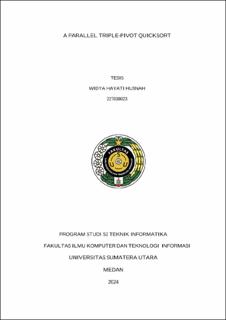| dc.description.abstract | The performance of sorting algorithms when applied to large datasets serves as a solution to optimize execution time. Sorting algorithms are crucial for real-time applications where response time is paramount, such as in financial systems or communications. There are numerous alternative sorting algorithms available that offer efficiency, speed, and ease of use. This study compares Parallel Triple-Pivot Quicksort and Parallel Single Pivot Quicksort, where careful array partitioning
techniques and pivot selection are employed to expedite the sorting process. Sorting
is conducted by dividing the array into sections based on the pivot and then
recombining the results using the quicksort algorithm. The analysis results indicate that Triple-Pivot Quicksort is more efficient than Single Pivot Quicksort. With the implementation of the concurrent future module, this algorithm effectively handles data ranging from 200,000 to 80,000,000. The Parallel Triple-Pivot Quicksort algorithm provides an average speed ratio approximately 205.66171 times faster than
Parallel Single Pivot Quicksort for data of size 10^2. However, the limitations of this algorithm are evident when dealing with larger datasets, such as in cases of data sized 60,000,000 and 80,000,000 (10^4). Testing on an Intel® Core™ i5-1135G7 processor revealed issues with overheating up to 920°C, leading to unreliable execution times. | en_US |


